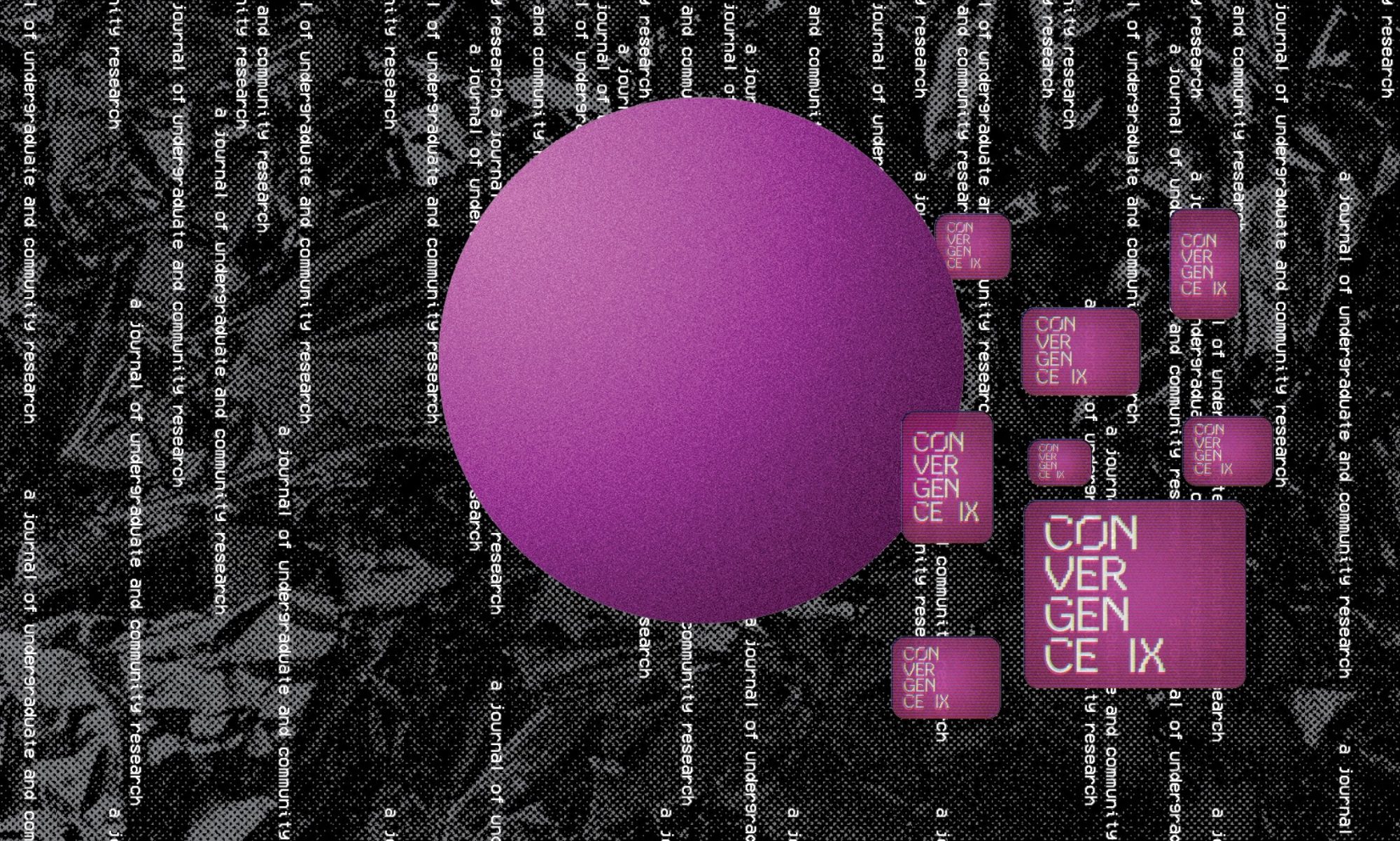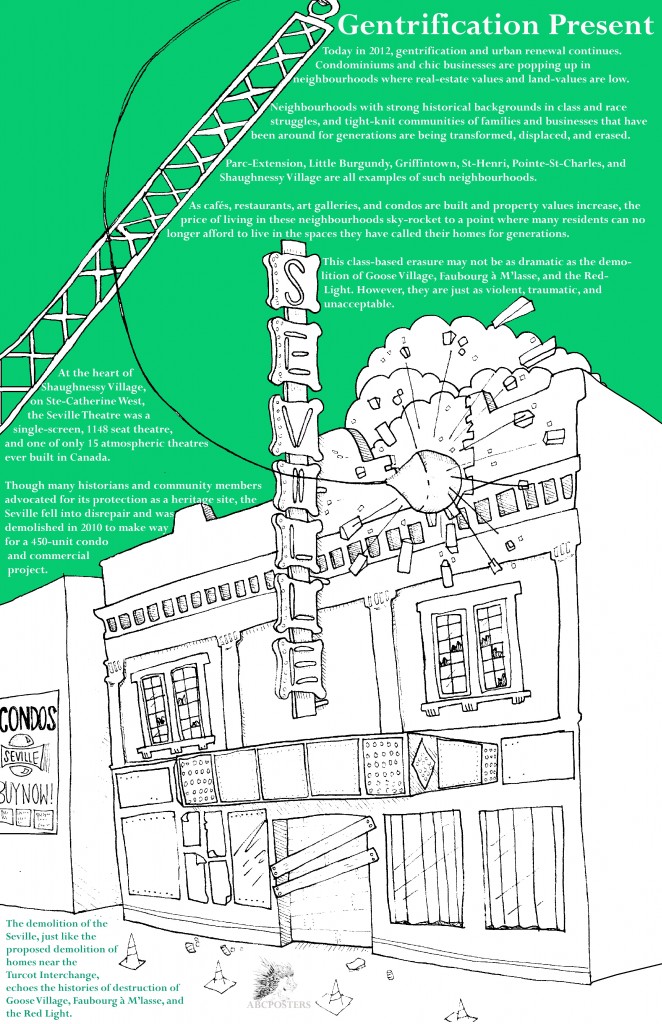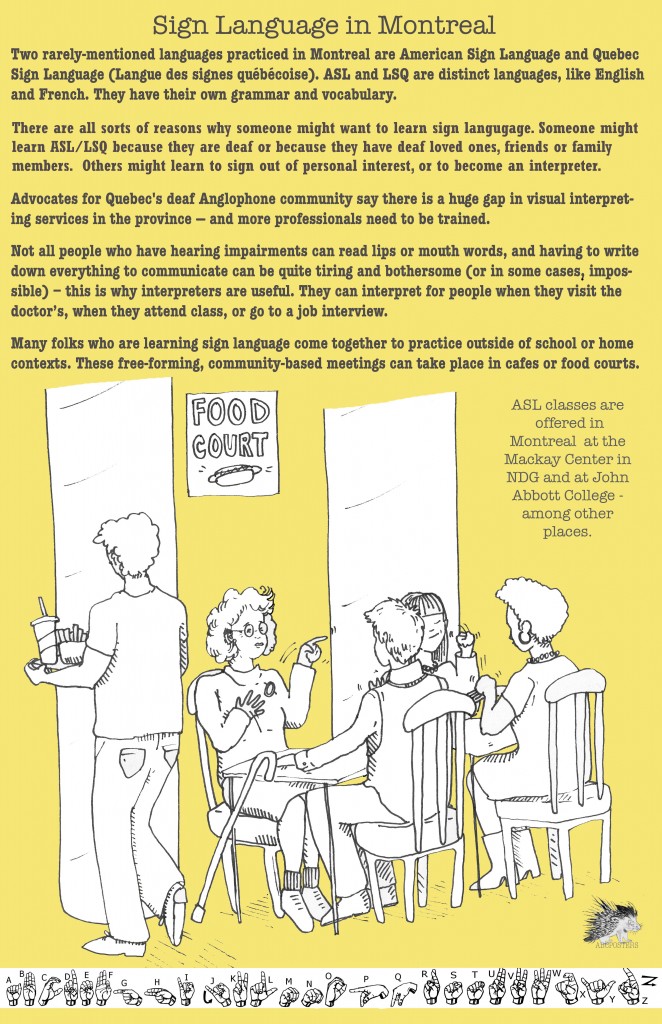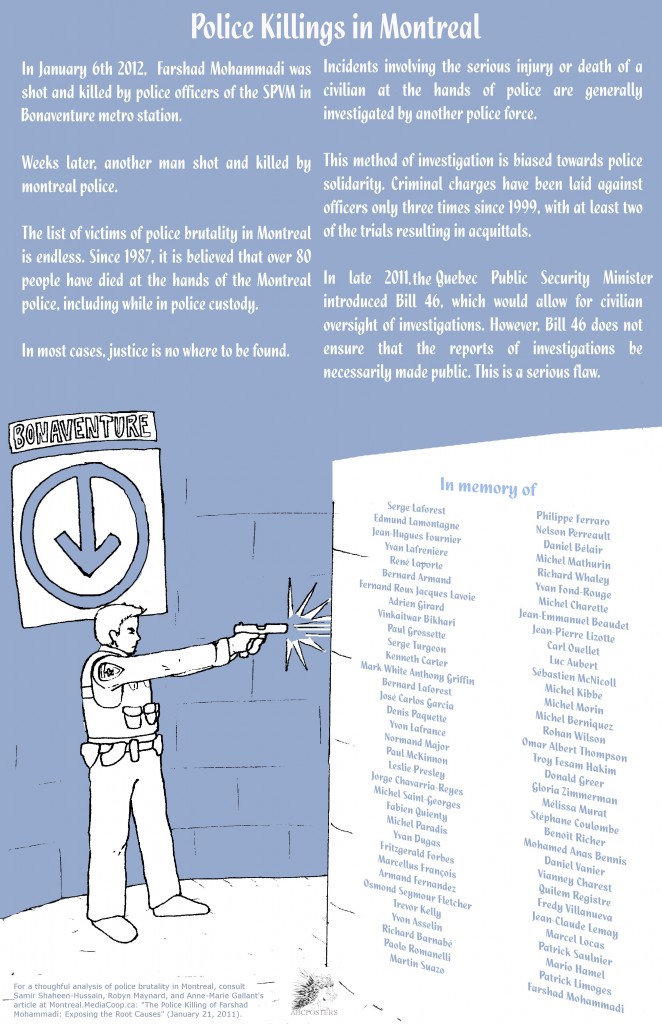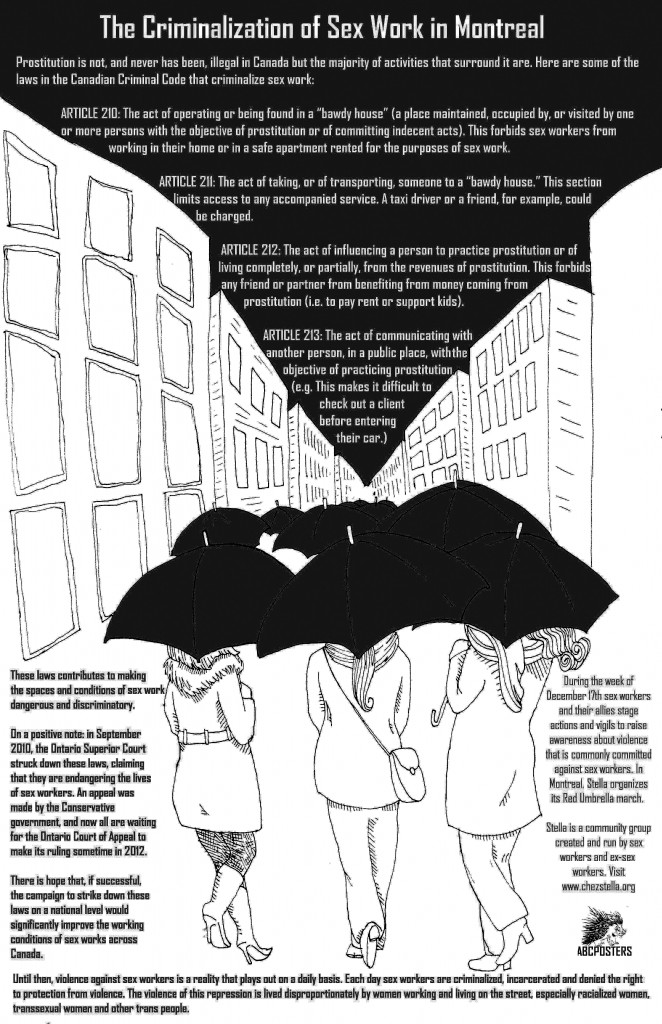kelly pennington
This paper was presented at Study in Action 2012, Montreal.
(((Kelly is an Urban Planning undergraduate student at Concordia. In addition to working with Right to the City, she is a collective member of Le Petit Velo Rouge. She is currently engaged in mobilising around the Quartier de Grands Jardin urban revitalization project.)))
The idea of citizen participation is a little like eating spinach: no one is against it in principle because it is good for you. Participation of the governed in their government is, in theory, the cornerstone of democracy – a revered idea that is vigorously applauded by virtually everyone. The applause is reduced to polite handclaps, however, when this principle is advocated by the have-not blacks, Mexican-Americans, Puerto Ricans, Indians, Eskimos, and whites. And when the have-nots define participation as redistribution of power, the American consensus on the fundamental principle explodes into many shades of outright racial, ethnic, ideological, and political opposition.
Sherry R. Arnstein 1969, 216
In the spring of 2011, public consultations were held regarding a revitalization plan for the west end of Montreal’s downtown known as Shaughnessy Village or, as it has been rebranded, the Quartier des Grands Jardins. A special planning program (or SPP) was jointly created by the City of Montreal and the table de concertation du centre-ville ouest, a coalition meant to represent community organisations, residents, private actors and local authorities (Table 2010). Over seventy groups and individuals voiced their opinions throughout the process of consultations, and many more attended informational and question sessions. Over nine months have passed since the sessions were held and the only acknowledgement thus far has been a summarized documentation of the opinions presented; no mention of intentions to adhere to these demands or concerns has been formally made. Through reflections on my experience with the Quartier des Grands Jardins consultation process, I seek to show that, within the context of neoliberal governance, public consultation is simply a process of self-legitimization that coopts democratic ideals in order to legitimize decisions already made, renders less important other means of protest, and ultimately holds no one accountable to the public which is meant to be represented.
the neoliberal city: a (very) brief overview
In past decades, the role of cities, as well as the way in which they are governed, has undergone a massive shift. This can be viewed as the move from a managerial, distributive role to an entrepreneurial one seen in tangent with the fall of Fordism (Harvey, 1989), but is also as representative of shifting geographies of scale. In the context of globalization, the role of nations has become increasingly negligible; power has shifted not just in the ways of supranational bodies and corporations, but additionally towards cities and city regions (Agnew et al, 2001). Lacking the fiscal or political capacity to assume this new responsibility, cities have further placed the onus on “professionalized quasi-public agencies empowered and responsible for promoting economic development, privatizing urban services, and catalyzing competition among public agencies” (Leitner et al, 2007, 4). These dynamics are posited as moves towards cost reduction, increasing flexibility, accountability, as well as greater efficiency of public administration (Elzina, 2010), and a hegemonic discourse contingent on a technocratic vision of city managing; governance as opposed to government. It can be seen as a move from centrist, hierarchical planning in favour of a more decentralized approach, not as a means to promote democratic processes, but in order to avoid bureaucracy (Swyngedouw et al, 2002). Consequently, in order for citizens to engage in decision-making, they must “understand how to perform actively as a citizen in order to claim a right to the city, […] be entrepreneurial and to develop the capacity to be an active agent in claiming their urban space” (Ghose, 2005, 64). The devolution of state authority has resulted in decreased accountability towards the public, placing the burden on those who must actively seek out their ‘right to the city’.
quartier des grands jardins: the consultation process
The Quartier des Grands Jardins project was proposed as an attempt to revitalise an area which is seen to be showing signs of urban decay. With plans to promote built heritage, improve quality of life and stimulate economic activity (Arrondissement de Ville Marie), one of the key goals seems to be linking the urban socioeconomic fabric of the city of Montreal which, currently, experiences a slight glitch in the ostensibly labelled no-man’s land that is Shaughnessy Village. The plan, created by the borough and the previously mentioned table de concertation, is a classic example of inner-city gentrification. While the project’s rhetoric is brimming with grand claims of stability, sustainability and so-called “quality of life”, a critical reading confirms that the ultimate goals are maintaining a competitive edge and the attraction of capital through becoming more appealing to “the outsider, the investor, developer, businesswoman or –man, or the money packed tourist” (Swyngedouw et al, 2002, 545-6). Given the composition of the table de concertation, this comes as no surprise.
In its mandate, the table stands for citizen democracy and representation of owners, renters, investors, students, merchants and community organisations alike (Table 2010). The board, however, tells a different tale. Of the six that sit on the board of directors, five have direct economic stakes in the area, speaking for; educational institutions, developers, and the city of Montreal. The larger board of twenty-four consists mainly of development firm CEOs, real estate owners, corporations, city committee members and large institutions; only one resident and four representatives from community organisations sit on the table de concertation (Table 2010). These so-called community representatives have been tasked with creating a plan which embodies everyone’s interests, but it is evident that the main goals seek to increase economic vitality; social welfare is supposedly going to arise via trickle down benefits.
Throughout the process of consultation, public opinions proved to be decidedly diverse. Many spoke of issues of green space, personal security and general deterioration, others presented more critical views on the lack of affordable and social housing, increased police presence and the questionable roles of certain institutions. While demands for trees on traffic islands and concerns about safety (for some) in public parks were met by the commissioners with serious questions and concerns, demands that would radically change the plans were acknowledged by silence. There was a general disinterest in engaging with issues that significantly questioned the SPP (special planning program), leading us to believe that the consultation process, though effective for less political or symbolic decisions – such as green space and bike paths – is an ineffective route to questioning larger issues of urban governance.
public consultation or citizen placation?
The widespread adoption of the language of participation across a spectrum of institutions, from radical NGOs to local government bodies to the World Bank, raises questions about what exactly this much-used buzzword has come to mean. An infinitely malleable concept, ‘participation’ can be used to evoke – and to signify – almost anything that involves people.
Cornwall, 2008, 269
The process of consultation is in and of itself a necessary step towards the democratization of decision making; previous top-down methods of policy writing and implementation certainly left little room for citizen input. Nonetheless, this new trend towards participation has become a “hegemonic discursive resource” (Moini, 2011, 151) for the stabilization of neoliberal policies that have been shown to have little impact on actual policy, effectively becoming a tool by which projects achieve public approval under the guise of democratic process (Moini, 2011).
In the late ‘60s, Sherry Arnstein famously described what she called the “Ladder of Citizen Participation”. It included eight “rungs” of participation within three categories: non-participation, degrees of tokenism and degrees of citizen power (Arnstein, 1969). Ranging from manipulation and therapy to citizen control, the ladder provided a skeleton in order to “cut through the hyperbole” (217) and understand the different degrees of citizen power given through various mechanisms. Public consultation falls in the middle, under the category of tokenism. While it provides a necessary platform for voices to be heard, “there is no follow through, no ‘muscle’, hence no assurance of changing the status quo” (217). In the case of Montreal, this is a harsh reality. Although the official policy regarding public participation notes that follow-up measures are necessary, the only official process is the re-evaluation of the consultation process itself, not of the issues brought under public scrutiny (Ville de Montreal, 2002). It therefore comes as no surprise that, over a year since the consultation, there has been no public recourse regarding the concerns brought forward.
Moreover, the inclusion of citizens in such “community” roundtables as the table de concertation is meaningless without mechanisms in place to ensure that groups are accountable to citizen voices. While Montreal has claimed it would attempt to provide information to the greatest number of people, especially “those who are often marginalized or difficult to reach” (Ville de Montreal, 2002, 2) not only is there little evidence that the city is making this effort, but this overlooks the fact that much of the population would not feel comfortable, doesn’t have the time or simply wouldn’t be allowed to contribute to formalized means of public engagement. Working parents with little free time, those who feel their opinion is not sufficiently refined or important and those who are unwelcome in private spaces, such as many affected homeless people in the case of the Quartier des Grands Jardins, are just some who are excluded by the nature of the process. Due to the fact that Montreal deems public consultation the “appropriate practice [for the] exercise of participatory democracy” (Ville de Montreal, 2002, 2), these people are left with no other ‘proper’ means of voicing their opinions. By making other forms of resistance “less acceptable than seeking a seat at the consultation table” (Cornwall, 2008, 282), the city delegitimizes all other methods of democratic intervention.
The use of terms such as “participatory” and “democratic” have become significant tools in the branding of projects as products of a collaborative process. Such cooptation allows developers and city officials to “claim that all sides were considered, but makes it possible for only some of those sides to benefit” (Arnstein, 1969, 216). When coupled with the fact that cities are increasingly managed by small partnerships and governing bodies, the rhetoric frequently exalts this new scale of decision making: local people enacting self-determination. This can be used to “lend a moral authority” while decisions remain “open to being selectively read and used by those with the power to decide” (Cornwall, 2008, 270). Expanding on this, it has been stressed that the decisions that are influenced by citizens “tend to remain trapped at the micro-local level and to avoid questioning power structures […] envisig[ing] the citizen as a mere user of public services” (Sintomer and de Maillard, 2007, 523). The crisis of such democratic processes is in this inherent watering down of political stances so as to meet the palates of the majority while fringe concerns and opinions are seen to be less important or relevant. By necessarily excluding so many from a process that is seen to be the only platform for resistance, marginalized voices are even less likely to be heard. As a result, the floor is cleared of those less controversial proposals as dissenting opinions are pushed elsewhere. Creating the image of a more unanimous voice makes it even easier for decision makers to demonstrate citizen support while exclusion of more radical opinions allows policy to be depoliticised, upholding the technocratic paradigm of neoliberal efficiency.
conclusion: what next?
The process by which cities adopt and promote the ideals of participation represent a cooption of democratic principles used to endorse projects which have already been planned. In essence, “what citizens achieve in all this activity is that they have ‘participated in participation.’ What powerholders achieve, is the evidence that they have gone through the required motions of involving ‘those people” (Arnstein, 1969, 219). With the shiny seal of public approval, the neoliberal city can claim citizen participation without the bureaucratic inefficiencies of true democratic process.
So what happens next? Are we to demand that the city reform its policies to assure action on all demands? Are we to amass numbers too large to ignore? First, we must acknowledge the simple fact that everyone’s interests will not be voiced or heeded, no matter the structure for expressing them. Cities are increasingly diverse spaces which inevitably represent many differing opinions. Any process that seeks to highlight the desires of the majority will unavoidably result in marginalization. So is the best option to create the majority?
Perhaps for those who wish to combat larger systems of neoliberal urban governance, the process of consultation is not the most effective path. While it is not without value, participation also gives clout to the systems we are attempting to change by acknowledging that, in order to change things, we must first ask permission or find ourselves a seat at the table. Direct democracy may be best sought by acknowledging that “the core of the right to the city is more generally the right to inhabit the space, a right opposed to the right of property and profitability” (Purcell, 2008, 179). These rights will inherently clash with the growth machine of the neoliberal city, hence the space for action may not be within its own mechanisms for participation. The public consultation process remains a step in the right direction. However, within the context of neoliberal urbanism, the chances for meaningful change are marginal. By creating a means for already made plans to achieve a stamp of approval, cities can create a guise of democratic process without any true form of accountability to what is being demanded, rendering citizen participation a tool of self-legitimization for the neoliberal city.
works cited
Agnew, John, Allen J. Scott, Edward Soja and Michael Storper. 2001. “Global City Regions.” In Global City Regions: Trends, Theory, Policy, edited by Allen J. Scott, 11-30. Oxford: Oxford University Press.
Arnstein, Sherry R. 1969. “A Ladder of Citizen Participation.” Journal of the American Institute of Planners 35: 216-224.
Arrondissement de Ville-Marie. 2011. “Special Planning Program: Quartier des Grands Jardins.” Last modified March, 2011. http://ocpm.qc.ca/sites/default/files/pdf/P47/3a1.pdf
Concordia Community Working Group. 2011. “Mémoire Oral: Dans le cadre des consultations publiques du PPU Les Grand Jardins.” Last modified March, 2011. http://ocpm.qc.ca/sites/default/files/pdf/P47/7a38.pdf
Cornwall, Andrea. 2008. “Unpacking ‘Participation’: Models, Meanings and Practices.” Community Development Journal 43: 269-283.
Elzina, Aant. 2010. “Systematic Limitations to Citizen Participation in Dominant Policymaking Regimes: The Case of Urban Planning.” Paper presented at Implementation in Inter- and Transdisciplinary Research, Practice and Teaching Conference, Geneva, September, 2010.
Ghose, Rina. 2005. “The Complexities of Citizen Participation through Collaborative Governance.” Space and Polity 9: 61-75.
Harvey, David. 1989. “From Managerialism to Entrepreneurialism: The Transformation of Urban Governance in Late Capitalism.” Geografiska Annaler 71: 3-17.
Leitner, Helga, Eric S. Sheppard, Kristin Sziarto, and Anant Maringanti. 2007. Contesting Urban Futures: Decentering Neoliberalism. In Contesting Neoliberalism: Urban Frontiers, edited byHelga Leitner, Jamie Peck and Eric S. Sheppard, 1-25. New York: Guilford Press.
Moini, Giulio. 2011. “How Participation has become a Hegemonic Discursive Resource: Towards an Interpretivist Research Agenda.” Critical Policy Studies 5: 149-168.
Peck, Jamie, Nik Theodore and Neil Brenner. 2009. “Neoliberal Urbanism: Models, Moments and Mutations.” SAIS Review 29: 49-66.
Purcell, Mark. 2008. “Recapturing Democracy: Neoliberalisation and the Struggle for Alternative Urban Futures.” New York: Routledge.
Sintomer, Yves and Jacques de Maillard. 2007. “The Limits to Local Participation and Deliberation in the French ‘politique de la ville’.” European Journal of Political Research 46: 503-529.
Swyngedouw, Erik, Frank Moulaert and Arantxa Rodriguez. 2002. “Neoliberal Urbanism in Europe: Large-Scale Urban Redevelopment Project and the New Urban Policy.” Antipode 34: 542-577.
Table de concertation du centre-ville ouest. 2010. Last modified 2010 http://ocpm.qc.ca/sites/default/files/pdf/P47/3b.pdf
Ville de Montreal. 2002. “The Challenge of Participation: Montreal’s Public Consultation and Participation Policy.” Last modified 2002 http://ville.montreal.qc.ca/pls/portal/docs/page/prt_vdm_fr/media/documents/consultation_participation_en.pdf
